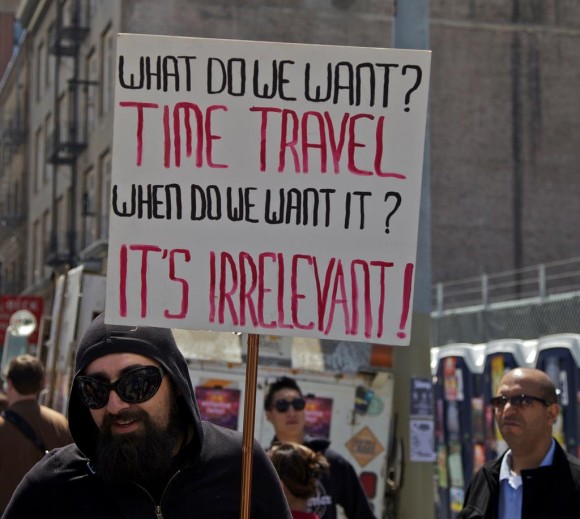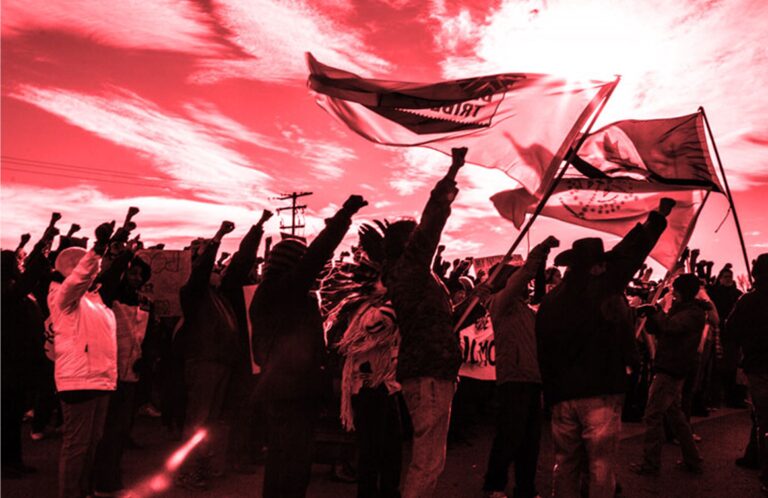Current thinking about evolutionary theory allows for the continuing development of sub-species and sub sub-species as a result of a constantly changing environment. The evolutionary process is not necessarily progressive, and new sub-species aren’t necessarily an improvement on the old. This seems to be the case in a developing split in our own family – Homo Sapiens Sapiens.
I have spent 35 years observing the development of what may be a distinct sub-species: Homo Demonstrandi: Man the Demonstrator. Of course I may be dead wrong, and the late British essayist Terry Pratchett may have been quite right when he proposed that the real taxonomical name for mankind should be Pans Narrans – the story telling ape.
Let me set aside my banana and tell stories of my encounters with Man the Demonstrator.
All evidence to the contrary sometimes being a first year university student really can be mind-expanding. Such was my experience many years ago when I was hanging around my University of Toronto residence on a late September Saturday afternoon engaging in that favorite student activity of procrastination. Suddenly I saw two individuals approaching. Judging from their demeanour, I thought they might be proselytizing for some cult (Hare Krishnas were big in those days) or else were really desperate encyclopedia salesmen.
They were proselytizing, but not for Krishna or Grolier. They were pushing copies of Socialist Worker and trying to convince us that all the world’s problems could be solved by “making the rich pay.” They, and others like them, came back to work the residence every few months. But I was a tough sell, especially in my second year when I joined a fraternity after a summer spent in the Armour School at the Combat Training Centre in Canadian Forces Base Gagetown. Still, I enjoyed arguing with the Socialist Worker hustlers because it afforded me further opportunities to procrastinate and I abstractly wondered where their zeal came from.
That second year Rhodesia was all the rage and Bobby Mugabe was the radical chic poster boy of the year (Africa never loses its power to amaze). His nation’s new name of Zimbabwe was becoming au courant on posters tacked up around campus. “All out for Zimbabwe!!!”, many of them shouted. I was a bit confused at first, wondering why it was such a big deal the fledgling country had lost a cricket match.
Yet the biggest demonstration that year on the U of T campus was inadvertently launched by my fraternity. For some reason not unconnected to the consumption of cheap beer, we decided to hold a party. Inspired by the Iranian hostage crisis that was underway at the time, we called it the “Death to the Ayatollah Party.” A cheap banner and an effigy of Ayatollah Khomeini were hung above the front door while we had a grand old debauch under his stern gaze.
In the morning as we coped with hangovers and a not inconsiderable mess, we discovered we had a hostage crisis of our own. A campus sorority had kidnapped our president (who was a sucker for feminine wiles) during the night; his return was assured if we made a charitable donation. The matter was discussed and a consensus reached that we would not bow to terrorists and would attempt to rescue the hostage. Refortified with refreshments, we set off on foot to retrieve our president, with the party banner and effigy at the front of our procession. By the time we were half-way across campus we had picked up several hundred students and the chant from our banner was echoing off the buildings.
The hastily summoned Campus and Toronto police had no idea what to do, let alone what we were doing. Eventually we accidentally collected a thousand demonstrators chanting “Death to the Ayatollah!”, but most were very confused when the march ended on the front lawn of a sorority house. Our revolutionary vanguard then stormed the house, but the masses were disinclined to follow. As I would later learn, this is common behaviour for Homo Demonstrandi.
Another summer went by at the Combat Training Center. As a reconnaissance officer, part of the syllabus involved learning about Soviet military equipment, tactics and organizations. There was a lot to learn. The Soviets were piling up plenty of tanks and guns in Central Europe in those days and us poor NATO types were outnumbered something like three-to-one. I could imagine a personal future that involved going to war if our governments weren’t careful.
Back at school the leftists apparently had the same thought, but a very different way of responding to it. As we now know – thanks to the Mitrokhin Archives – while the USSR was stocking up arms they also used their overseas Communist Parties and political fronts to rekindle the western peace movement. The domestic Marxists, Trotskyites, Socialists and Anarchists never took their marching orders directly from the Kremlin (and largely mocked Canada’s Communist Party as stooges). However, when the NATO nations undertook to keep pace with the Soviet build-up, it became necessary to campaign for “peace” and the tribes joined in common cause. H. Demonstrandi Peacenik was born.
My friends and I felt compelled to know more. My chum Dave – now the head of the history department in one of our universities – and I undertook some field observations. Clad in trench coats and fedoras, armed with cameras, binoculars and notebooks (the old fashioned kind), we climbed to a handy roof-top to watch one of the first big peace marches in Toronto.
One of our first observations was that the act of observing affects the observed. Typically the first reaction was consternation and alarm; followed by hostility; then a sort of satisfaction. As Dave put it, these three phases could be characterized as: “I’m being watched! How dare they watch me! I’m important enough to be watched!” In the decades since, I’ve noticed that conservative protestors (rare to be sure) only go through the first two phases.
I’ve also noticed that most protestors, whatever their political orientation, have shed any inhibitions they once had about being observed. Everyone now understands that demonstrations are political theatre, staged and scripted for the media, and calculated to deliver calibrated messages to as many eyeballs as possible.
Continuing fieldwork since the early 1980s yielded other discoveries, notably that Homo Demonstrandi often doesn’t have a very firm grasp of the issue they’re protesting. When Canada allowed the U.S. to test guidance systems for a new generation of cruise missiles on Canadian territory; the inevitable protests soon followed. When a flock of something-or-others-for-peace alighted with their placards on Nathan Phillips Square to interrupt an ice-carving contest during Toronto’s 1984 sesquicentennial celebration, I interviewed one:
Me: “So why are you against the cruise missile?”
Peacenik: “Cruise missiles suck, man!”
Me (cleverly baiting the subject): “Why?”
Peacenik (closing his eyes to call forth his key message briefing): “‘Cuz they’re first strike weapons and are non-verifiable!”
Me: “That’s not true, Soviet Air Defence would certainly detect the approach of the launch platforms, and bomber inventories are verifiable. Moreover, an inability to get target sets for static air defence platforms would not constitute a failure of early warning.”
Peacenik: “Cruise missiles suck man!”
Countering the arguments of H. Demonstradi may be easier than clubbing baby seals (and makes you as much of a bully), but it makes no difference, for they are almost impervious to logic. But it must be said that H. Demonstrandi can be capable of great powers of mimicry and may do more than parrot slogans. Almost any perusal of Socialist Worker will turn up articles where a complex social problem is resolved by feeding it into the hopper of the dialectical sausage maker; the author turns the crank and voila! “True worker solidarity” inevitably solves the issue.
Whatever “True worker solidarity” is, it must be powerful stuff. It apparently obviates the need for environmentalists to understand ecology, for peace activists to know about defence issues, and for “social justice”-seekers to comprehend anything about economics, criminology or even elementary street-smarts. I’ve seen H. Demonstradi blissfully unaware that they are proudly marching alongside gangsters and providing cover for vandals and looters.
Never did I see a better display of a total absence of common sense than at the 1988 G-7 Conference in Toronto. This time Dave and I consumed single malt and cigars from on high while watching the parade from the “People’s Summit” en route to the Conference venue. With some reluctance, we descended to the street to watch the “storming of barricades.” University Avenue was locked off by curb-to-curb crowd barriers, backed by an equally solid phalanx of police.
Elementary reconnaissance would have revealed that two parallel routes into the conference area were wide open and seemingly unguarded. But that would have defeated the protestors’ purpose – good visuals on television. The police were two-deep behind the barrier, but the media were four deep in front of it. Every time a demonstrator wrestled his way through the press of the press to hurl himself over the barricade, cameras bent on close-ups sealed off the breech; particularly when one of the more enthusiastic demonstrators slashed his own forehead with a razor and started screeching about police brutality.
It reminded me of the skit in Monty Python and the Holy Grail: “Come and see the violence inherent in the system. Help! Help! I’m being repressed!”
Some of the more astute observers of these kinds of events – like Christie Blatchford (then writing for the Toronto Sun) – had started to notice that the same faces always seemed to appear on the front lines. The bigger demonstrations were usually fleshed out with bused-in members of public service unions, but even then, the noisiest, angriest and most energetic protestors invariably seemed drawn from a core group of a couple hundred activists. In Britain, this phenomenon came to be known as the “Agitprop-rent-a-mob.”
Demonstrators often turn up with the wrong signs for a protest, evidently after missing the memo about the day’s theme. It hardly matters. The chants change little – “Two-four-six-eight, something, something ends in ate!” – and marchers are so well drilled that they can muster from column to picket to angry mob with the same speed and purpose that an infantry platoon demonstrates in elementary fieldcraft.
I still watch demonstrations; it’s free, more fun than the circus, and sometimes the cheekiness of the performers is amusing. Sometimes I even see things that give me comfort about the future of the sub-species, and humanity generally. In April 2002, I was in Washington making the rounds. Out on the streets, things were brewing for a major anti-IMF and World Bank protest, with a topping of good old “anti-US imperialism” for good measure.
The demo brought in a huge gathering of diverse American leftists and a strong contingent of apologists for the Jihad movement. I watched a throng of about 800 Islamists getting themselves worked up under a big black Shahada battle flag. On the outskirts of the chanting whirling mob stood a lone teenager wearing a gay rights t-shirt. His mind was clearly in conflict.
His forebrain was telling to enter the mob and express solidarity with the Islamists. He would take a tentative step in their direction, but then something deeper in his brain would cause him to retreat. An excited mob is a dangerous thing, and this is especially true of one composed of Salafist and Wahhabi activists. For as long as I watched him he did this shuffle, which seemed to me a struggle between the reason of his instinct and the irrationalism of his ideology.
Somehow, this was reassuring to me. H. Demonstradi is not fully lost to Homo Sapiens Sapiens so long as he is prepared to listen to reason. Hope abides.
~
John C. Thompson is a prolific writer and commentator on security issues who spent five years with the Canadian Institute of Strategic Studies and 24 with the Mackenzie Institute.








